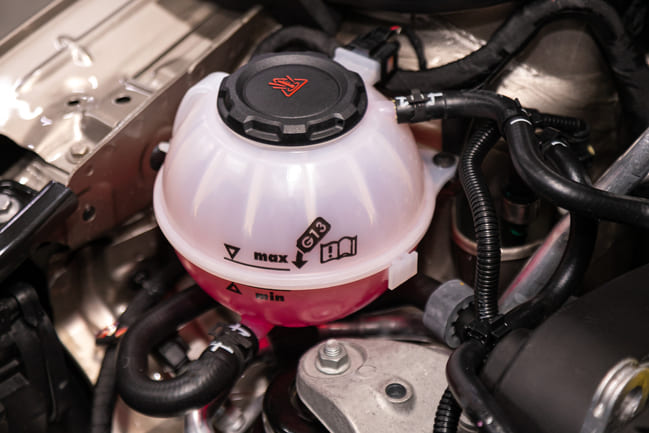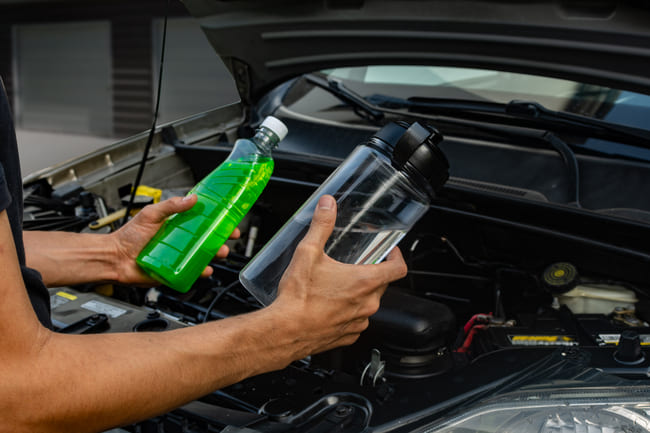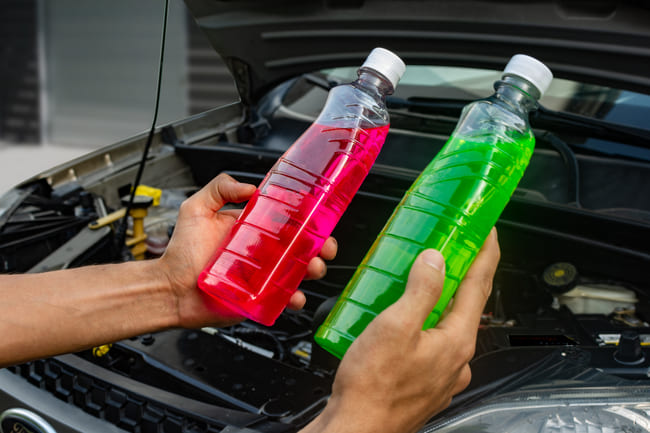
Heat dissipation via your car's coolant is very important for your engine. This is because when fuel is burned, not only mechanical energy is released, but thermal energy as well. A constant temperature also allows consistently high engine efficiency and optimal utilization of the fuel energy. All in all, most engines with a coolant pump have about 5-10 liters of total coolant. This not only flows around the cylinder head, but also around the cylinder block and is transported to the cooler via suitable lines.
Contents
What is the composition of the antifreeze in your engine?
The commercially available concentrates of antifreeze are in most cases liquids made up of water, certain additives and monoethylene glycol. There are basically two main tasks: First, the other chemicals ensure that the coolant does not freeze in winter and that rust does not form. To make the various concentrates of coolant G12 or coolant G13 ready for use, a 1:1 dilution is required in most cases. The manufacturers provide more detailed information. The best way to dilute is with purchased, distilled water, which is usually available at gas stations, for example. If you do not have such water to hand, you should still use water that is as pure as possible, which should definitely be low in lime. This is the only way to prevent the cooling circuit from becoming clogged.
When do you have to refill coolant

In most situations, it is no longer necessary to top up the engine with antifreeze on a regular basis. This is generally due to the fact that the systems are designed to be maintenance-free. In principle, there is an expansion tank for the coolant circuit in your engine compartment. This often also contains an indication of whether you should fill in coolant of type G12 or coolant of type G13. In addition, this component also has an identification for the minimum, but also for the maximum coolant level. In modern vehicles, there is often a situation where you only have to top up coolant if there are leaks in the system. These are usually hairline cracks or larger defects, such as marten bites on the lines. If the coolant level falls below the „Min“ mark, you should top up with a suitable antifreeze for your engine in the appropriate dilution. From time to time you should also check the composition of the coolant. You can use a suitable coolant tester for this. Please note that the display for the coolant usually only refers to its temperature and not necessarily to the actual fill level. If it lights up, then you should check your coolant.
The right blend of your coolant

If you want or need to add coolant, you will need the right antifreeze concentrate for the finished coolant in addition to distilled water. The vehicle manufacturer specifies which concentrate is required and how it must be mixed. Alternatively, you can also use ready-made mixtures. It is also important to remember that you should never mix incompatible antifreeze. If you disregard the relevant specifications, unwanted reactions between the different substances usually occur, which can ultimately lead to the cooler or the entire cooling circuit becoming clogged. Ultimately, this in turn can result in engine overheating, with the cylinder head gaskets often burning out as the weakest link. This quickly results in a total loss of your vehicle engine. In order for the engine cooling to work really efficiently, you should also regularly check your mechanical cooling fan.
Replacing the coolant in your car
There are situations when you should completely change your coolant. This may be necessary, for example, if you notice a major leak and don't know where your coolant is leaking. A comprehensive leak search can then only be carried out after the circuit has been emptied beforehand. The easiest way to identify a problem with a leak is to look at your coolant expansion tank. If the level there drops continuously and falls below the minimum, you should take a closer look at the cooler, the water pump and all the lines.
Another reason for a coolant change is if its color has changed abnormally. If this is no longer the original color or if you can even see suspended matter or rust particles, this working fluid should urgently be renewed. It can be worth hiring a specialist workshop to do the cleaning or rinsing the car radiator yourself, because this is the only way to remove any deposits and residues as completely as possible.
When draining the old coolant, be sure to catch it in a sufficiently large pan. This must have a volume of up to 10 liters, because there are often 5-10 liters of coolant in the circuit. After that, however, the question arises of how to dispose of the old coolant. This should never get into the groundwater and should not be disposed of down the drain. For the disposal of the cooling liquid, you must contact an appropriate expert. This is usually possible at the local gas station, at the recycling centers or at a car repair shop. The same applies if you want or have to dispose of the antifreeze concentrate.
You must then fill in new cooling water after you have eliminated any leaks. To do this, you should first consult the coolant table for your vehicle. It should be noted that the color of the coolant does not allow any conclusions to be drawn about its composition.

For example, you can't just mix a blue coolant with another blue antifreeze. What is important, however, are the characteristics of the corresponding coolant. Which coolants you could theoretically mix depends entirely on the products in question. For this reason, we strongly advise you to get the okay from your vehicle manufacturer in advance so that no serious errors occur.
Conclusion
Regular maintenance of your vehicle systems and regular replacement of the appropriate working fluids, which include your coolant in the car, helps to achieve a longer service life for your engine. The antifreeze in your car is of great importance because it ensures optimal heat dissipation in the cooling circuit. You should always pay attention to the correct composition and only use compatible products. It is also advisable to clean your cooling circuit from time to time. In addition, you should also ensure that the mechanical cooling fan is working properly, as this plays an equally important role in maintaining a constant engine temperature.
A tip from CarTipsandmore: If you should change the coolant in your If you want to check cars or even refill them, your engine must always be cold. This is the only way to ensure that you don't scald yourself, not only because the system is hot, but also because you are under pressure. In addition, you can only correctly determine the composition of the coolant when it is cold. If your engine is overheating, you must urgently stop and wait until it has cooled down again. If you do not have a suitable refill liquid at hand, you can top up your coolant with a little water (distilled water if possible). But there is another reason why you should never add coolant to a hot engine. This is because contact with the cold topping-up fluid can cause stress and also cracks in your engine and/or cooling circuit.
